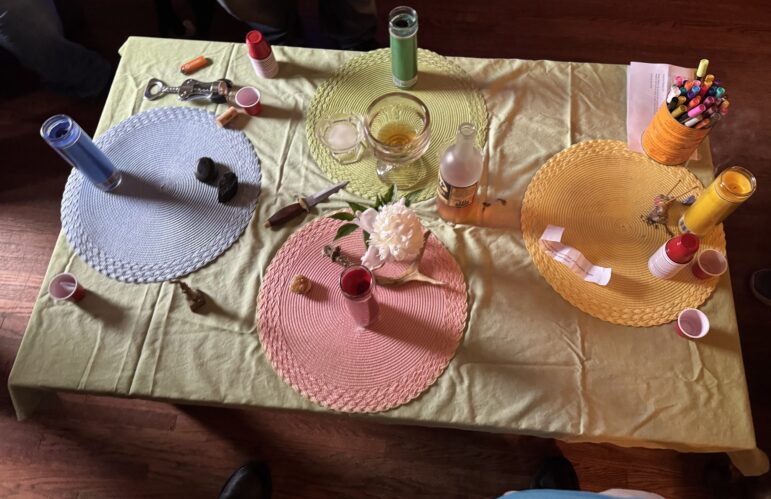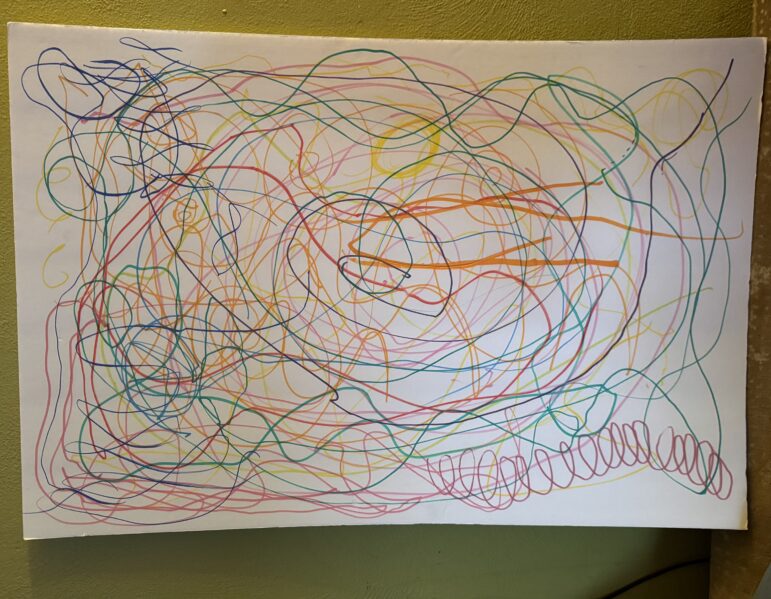
It had been raining all week in St. Louis, and the day my coven got together for Beltane was no different. My family drove to our covenmate’s house through the gray drizzle, my tires quietly slushing through the deep puddles that covered the road through East St. Louis’s old industrial zone, water spilling from the inundated, polluted earth. We joined the traffic on the Poplar Street Bridge over the Mississippi River and I found myself wondering what we would do about the Maypole.
In our branch of Wicca – supposedly we’re some bastard extraction of Alexandrian, but we have been on our own for about 50 years, and like Darwin’s finches, we’ve evolved in isolation – we have only a few consistent parts of liturgy across the sabbats. We usually call out the names of the dead at Samhain, and sometimes we remember to burn John Barleycorn at Harvest Home, and most years we determine who calls the quarters at Ostara by who finds the specially marked “elemental eggs.” But most holidays we write a whole new ritual and there’s no guarantee that any particular element will recur from year to year. I’ve been to Ostaras without the eggs and Samhains without the names of the dead. But I’ve never been to a Beltane without the Maypole. That one remains.

Maypole from Sabbatsmeet’s 2024 Beltane [E. Scott]
My covenmate had called me a few days before to ask if they could borrow the Maypole I have in my basement. I had remembered it as being tall, but not unmanageable, perhaps 10 feet tall. But once we dragged it into the backyard, we found it was taller than that – 12, 14 tall, and thick, a rounded-off four by four. They looked at their SUV and shook their head. There was no way they could get it across the river, even with a red flag trailing off the end like a ribbon. Now, driving through the rain, I felt glad that we hadn’t been able to load the pole up – there wouldn’t have been any point in trying to dance the Maypole in rain and mud like this. Our coven stretches over generations, from people in the 70s to newborns, and somebody would have broken an ankle.
But still – how could we have Beltane without a Maypole?
We brought in our toddler and a big pot of soup, a “monastery minestrone.” It’s from one of my favorite cookbooks, Victor-Antoine D’Avila Latourrette’s Twelve Months of Monastery Soups, which arranges its offerings by the month, promising meals that develop and evolve as we turn around the wheel of the year. We sat the pot on the stove next to the other offerings people had brought: smoked chicken wings, mac and cheese, cowboy caviar, peach pie. Our covenmate’s dogs swarmed up and gave the toddler friendly sniffs, which made him giggle madly. We gave each other big hugs and looked for places to sit. Ordinarily, we would have spread outside, and even today, a few people at a time walked out in the rain to smoke beneath a pop-up canopy. But for the most part we were stuck inside, and we huddled close, tucked next to each other on couches or leaning close to one another against the kitchen counter.

Sabbatsmeet Beltane altar, May 2025 [courtesy]
My covenmate had set up a beautiful altar against the northern wall with doilies and candles in pastel shades, mint, goldenrod, rose red and cornflower blue. Someone brought a freshly bloomed peony and set it in the center, near the chalice and athame. My covenmate flagged me down and asked if I wanted to act as the high priest, and I nodded. “What’s the plan for the Maypole?” I asked.
They said not to worry – they had a plan in mind.
In the middle of the ritual, after we had drawn the circle and called the quarters, they cleared the center of the altar and laid down a sheet of posterboard and a cup full of paint markers. “Here’s what we’re going to do,” they said. Everyone would take one of the markers and draw the path they would have danced if we could have planted a pole in the ground – spirals and squiggles circumnavigating around the middle of the board.
We sang the Goddess Chant as we drew, Isis Astarte Hecate Demeter Kali Inanna, and we weaved in and out across the living room, one of us bending down to trace a line around the board while another swiveled back having drawn. We bumped into one another and forgot to take the caps off and traced over and under one another, layering our steps in this dance of hands and ink.
Near the end of the chant, I uncapped a marker and handed it to my three-year-old. I patted him on the back and encouraged him to go up and add his line to the Maypole Dance. He looked thoughtfully at the orange pen in his hand, then staggered up to the altar and drew three thick, straight lines right through the center of the dance. Everyone laughed; it’s what he would have done if we had given him a ribbon and set him loose outside.

Maypole Dance [Sabbatsmeet]
We closed up the circle and sent the elements back to their homes, and started to clean up for the feast. My covenmate took the posterboard in their hands and looked at it, smiled, and hung it over the back of the couch.
There is an argument, I suppose, for adherence to absolute tradition, to the idea that ritual is about repetition, that we connect most deeply to our traditions when we reenact them again and again. But I find there is always space for growth, change, adaptation. We can maintain our bond with the seasons even as the seasons themselves change around us; we can dance the Maypole indoors when it rains, even without ribbons, even without a pole. A tradition is a living thing. It has roots. It spreads its branches, it grows.
The Wild Hunt is not responsible for links to external content.
To join a conversation on this post:
Visit our The Wild Hunt subreddit! Point your favorite browser to https://www.reddit.com/r/The_Wild_Hunt_News/, then click “JOIN”. Make sure to click the bell, too, to be notified of new articles posted to our subreddit.